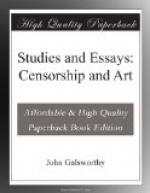Having observed that there is no reason whatever for the exemption of Literature, let us now turn to the case of Art. Every picture hung in a gallery, every statue placed on a pedestal, is exposed to the public stare of a mixed company. Why, then, have we no Censorship to protect us from the possibility of encountering works that bring blushes to the cheek of the young person? The reason cannot be that the proprietors of Galleries are more worthy of trust than the managers of Theatres; this would be to make an odious distinction which those very Managers who uphold the Censorship of Plays would be the first to resent. It is true that Societies of artists and the proprietors of Galleries are subject to the prosecution of the Law if they offend against the ordinary standards of public decency; but precisely the same liability attaches to theatrical managers and proprietors of Theatres, in whose case it has been found necessary and beneficial to add the Censorship. And in this connection let it once more be noted how much more easily the ordinary standards of public decency can be assessed by a single person responsible to no one, than by the clumsy (if more open) process of public protest. What, then, in the light of the proved justice and efficiency of the Censorship of Drama, is the reason for the absence of the Censorship of Art? The more closely the matter is regarded, the more plain it is, that there is none! At any moment we may have to look upon some painting, or contemplate some statue, as tragic, heart-rending, and dubiously delicate in theme as that censured play “The Cenci,” by one Shelley; as dangerous to prejudice, and suggestive of new thought as the censured “Ghosts,” by one Ibsen. Let us protest against this peril suspended over our heads, and demand the immediate appointment of a single person not selected for any pretentiously artistic feelings, but endowed with summary powers of prohibiting the exhibition, in public galleries or places, of such works as he shall deem, in his uncontrolled discretion, unsuited to average intelligence or sensibility. Let us demand it in the interest, not only of the young person, but of those whole sections of the community which cannot be expected to take an interest in Art, and to whom the purpose, speculations, and achievements of great artists, working not only for to-day but for to-morrow, must naturally be dark riddles. Let us even require that this official should be empowered to order the destruction of the works which he has deemed unsuited to average intelligence and sensibility, lest their creators should, by private sale, make a profit out of them, such as, in the nature of the case, Dramatic Authors are debarred from making out of plays which, having been censured, cannot be played for money. Let us ask this with confidence; for it is not compatible with common justice that there should be any favouring of Painter over Playwright. They are both artists—let them both be measured by the same last!




